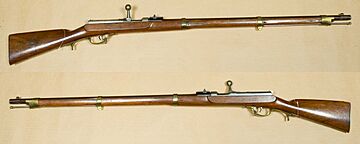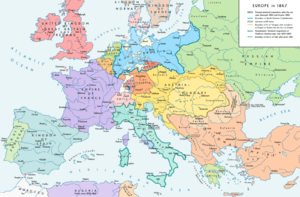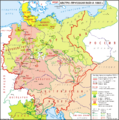Austro-Prussian War facts for kids
Quick facts for kids Austro-Prussian War |
|||||||||
|---|---|---|---|---|---|---|---|---|---|
| Part of the wars of German unification and the Austria–Prussia rivalry | |||||||||
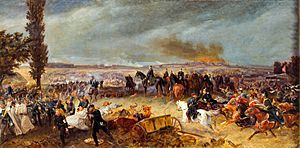 Battle of Königgrätz, by Georg Bleibtreu. Oil on canvas, 1869 |
|||||||||
|
|||||||||
| Belligerents | |||||||||
|
Prussian-led German states
|
|
||||||||
| Commanders and leaders | |||||||||
|
|||||||||
| Strength | |||||||||
|
637,262 |
522,203
|
||||||||
| Casualties and losses | |||||||||
|
List
|
|||||||||
The Austro-Prussian War was a big fight in 1866. It was also called the Seven Weeks' War or the German Civil War. This war was mainly between the Austrian Empire and the Kingdom of Prussia. Many smaller German states joined one side or the other.
Prussia also teamed up with the Kingdom of Italy. This link made the war part of Italy's fight for independence. The Austro-Prussian War was a key event in the long-standing competition between Austria and Prussia. It ended with Prussia becoming the most powerful German state.
A major outcome of the war was a shift in power. Austria lost its top spot among German states. Prussia became the main leader. The old German Confederation was broken up. In its place, the North German Confederation was formed. This new group included all the northern German states but not Austria. Italy also gained Veneto from Austria.
Contents
The Austro-Prussian War
Why the War Started
The war began because Prussia and Austria disagreed. They had both taken over Schleswig-Holstein from Denmark in 1864. They were supposed to share control of these areas. But then, Austria made a decision about Holstein that Prussia didn't like. Prussia said this broke their agreement.
Austria disagreed, saying their decision was fine. In March 1866, Austria moved more soldiers to its border with Prussia. Prussia responded by getting some of its own soldiers ready.
Leaders Make Plans
Otto von Bismarck, the leader of Prussia, made a deal with Italy. Italy agreed to join the war if Prussia fought Austria within three months. This gave Bismarck a reason to start the war quickly. Italy's help would make Austria fight on two fronts.
Austria then moved its southern army to the Italian border. Italy and Austria both called up all their soldiers. Prussia also prepared its entire army.
The War Begins
Austria tried to solve the problem by taking it to the German Diet. This was a meeting of German states. But Prussia saw this as breaking their agreement. On June 9, Prussia invaded Holstein.
When the German Diet decided to prepare for war against Prussia, Bismarck declared the old German Confederation was over. On June 15, the Prussian army invaded Hanover, Saxony, and Hesse. Italy declared war on Austria on June 20.
Who Fought Whom
Before the war, both Austria and Prussia tried to get allies. Most southern German states joined Austria. These included Bavaria and Württemberg. Smaller states like Baden and Nassau also sided with Austria. Many German princes joined Austria to keep their power.
Most northern German states joined Prussia. These included Oldenburg and Mecklenburg. Italy joined Prussia because it wanted to take back Venetia from Austria. Bismarck promised Italy that Prussia would not make peace until Italy got Venetia.
Other powerful countries stayed out of the war. France expected Prussia to lose, so it waited to gain land later. Russia was still upset with Austria from an earlier war.
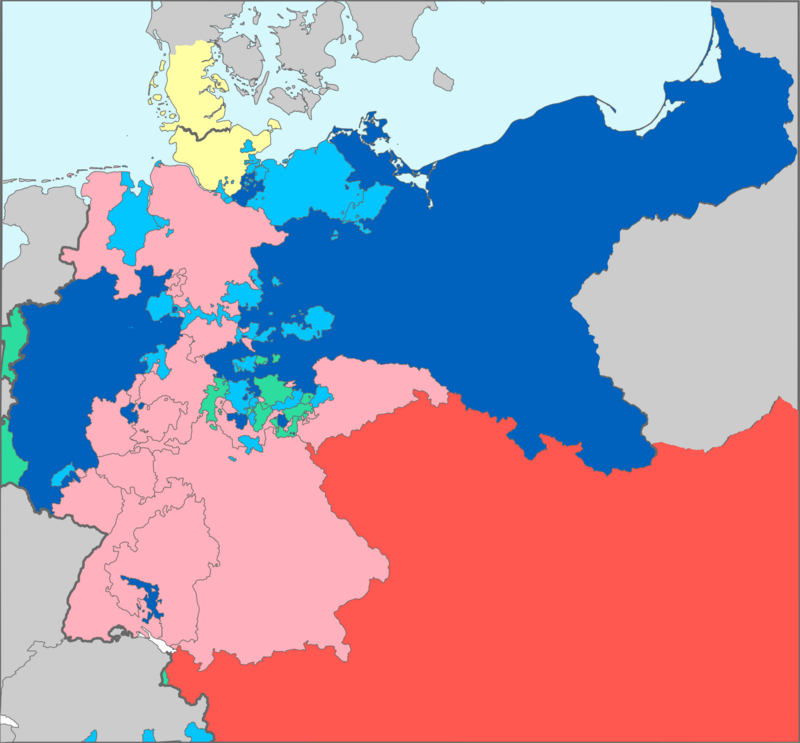 |
||
| Neutral/passive | ||
|
|
|
Disputed Territory
|
||
How the War Unfolded
This war was the first major conflict in Europe in seven years. It used new technologies like trains to move soldiers. Telegraphs helped send messages quickly over long distances.
Prussian Army Advantages
Prussian soldiers had a special rifle called the Dreyse needle gun. This gun could be loaded very fast, even when a soldier was lying down. Austrian soldiers used older rifles that loaded slowly, usually while standing up. This gave Prussia a big advantage in battles.
The Prussian army was also better trained. All Prussian men had to serve in the army. They trained continuously. Austrian soldiers were often sent home and had to be retrained when war broke out.
Fast Movement and Strategy
Prussia's army could move very quickly. Their railway system was better developed than Austria's. This meant they could gather many soldiers faster. The Prussian general, Helmuth von Moltke, planned this carefully. He knew speed was key.
He said Prussia could gather 285,000 men in 25 days using five railway lines. Austria, with only one main railway line, would take 45 days to gather 200,000 men. This speed allowed Prussia to surprise the Austrians.
Key Battles
The main fighting happened in Bohemia. The Prussian army moved quickly into Saxony and Bohemia. On July 3, the two sides met at the Battle of Königgrätz. Prussia won a huge victory here. Austrian losses were much higher than Prussia's. A ceasefire was agreed upon on July 22.
In other areas, Hanover's army beat Prussia at the Second Battle of Langensalza. But they had to surrender soon after. Prussian armies also fought against Bavaria and other southern German states.
Austria had more success against Italy. They defeated Italy on land at the Battle of Custoza and at sea at the Battle of Lissa. However, Italian forces led by Giuseppe Garibaldi won a battle in Trentino. Prussia's peace with Austria forced Italy to stop fighting. Italy still gained Veneto later.
- 24 June, Battle of Custoza: Austrian army defeats Italian army.
- 27 June, Battle of Náchod: Prussians defeat Austrians.
- 27 June, Battle of Trautenau (Trutnov): Austrians slow down Prussian advance.
- 27 June, Battle of Langensalza: Hanover's army defeats Prussia's, but Hanover surrenders two days later.
- 3 July, Battle of Königgrätz (Sadová): A major Prussian victory against Austrians.
- 20 July, Battle of Lissa (Vis): The Austrian fleet beats the Italian one.
- 21 July, Battle of Bezzecca: Giuseppe Garibaldi's troops defeat an Austrian army.
What Happened After the War
Bismarck wanted to make peace quickly. He didn't want Austria to feel too bitter or for France or Russia to get involved. The Peace of Prague was signed on August 23, 1866.
This treaty ended the German Confederation. Prussia took over four of Austria's former allies. Austria was permanently kept out of German affairs. This allowed Prussia to form the North German Confederation the next year. This new group included all German states north of the Main River.
Prussia did not take any land from Austria itself. This was important because it allowed Prussia and Austria to be allies later. The war made Prussia the most powerful state in Germany.
Changes for the Losers
- Austria: Gave up the region of Venetia to France, which then gave it to Italy. Austria lost all its power over the former German states. Austria's defeat led to the creation of Austria-Hungary the next year.
- Schleswig and Holstein: Became part of Prussia.
- Hanover, Hesse-Kassel, Nassau, Frankfurt: These areas were taken over by Prussia. They were combined to form a new Prussian province.
- Saxony, Saxe-Meiningen, Reuss-Greiz, Schaumburg-Lippe: These states were not taken over. But they joined the North German Confederation soon after.
Changes for Neutral States
- Liechtenstein: Became an independent country. It declared itself neutral. It kept close ties with Austria.
- Limburg and Luxembourg: These states became part of the Kingdom of the Netherlands. Luxembourg was promised independence and neutrality.
See Also
- Wars and battles involving Prussia
Images for kids


